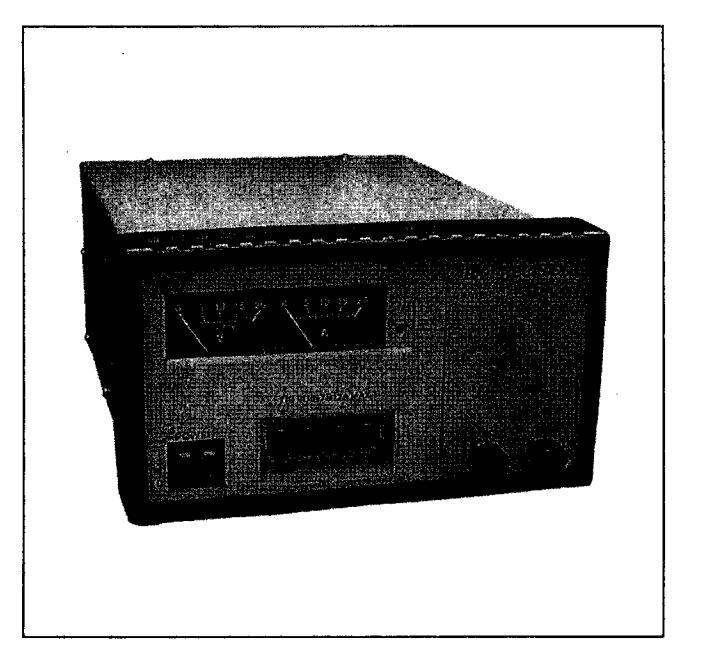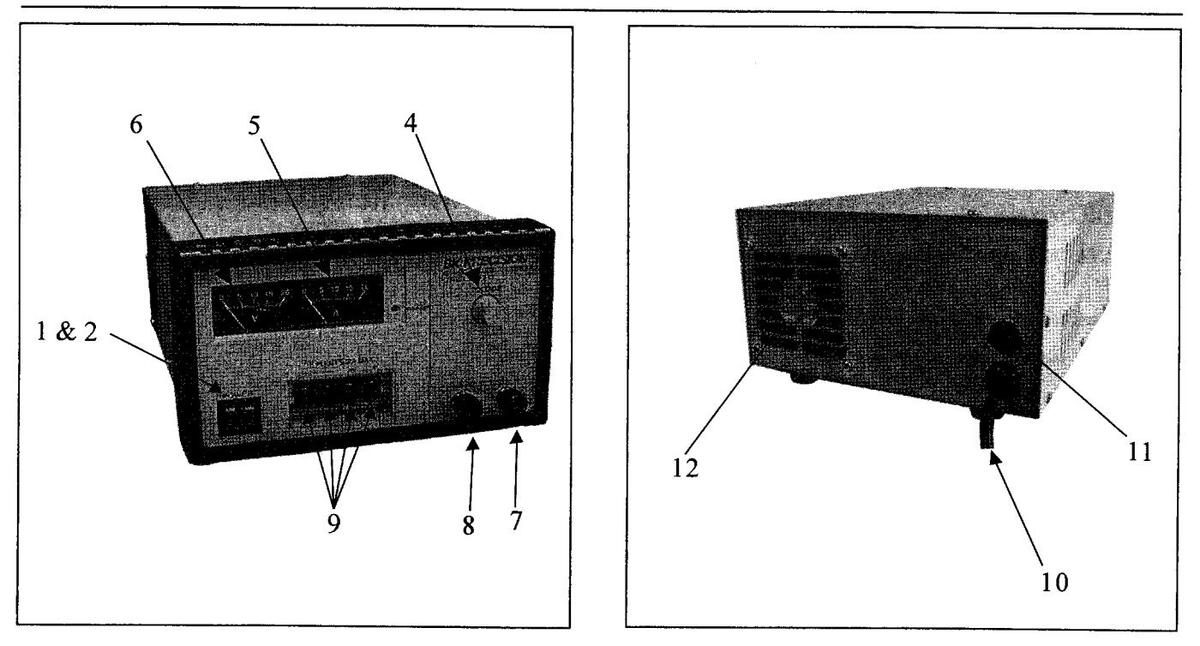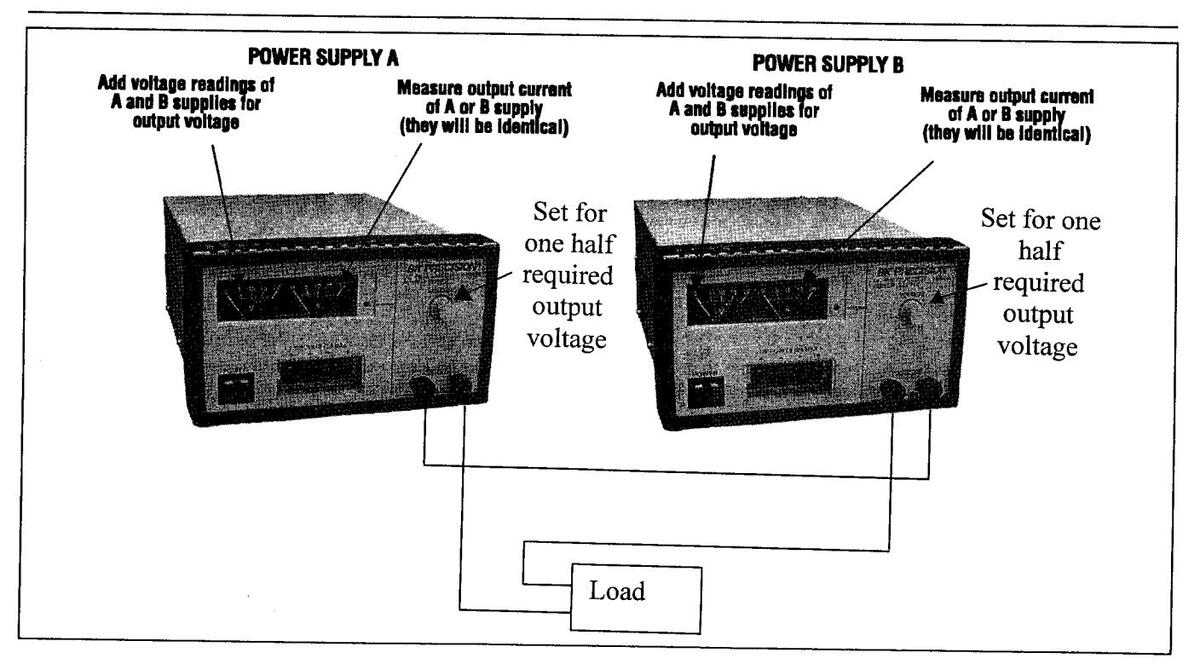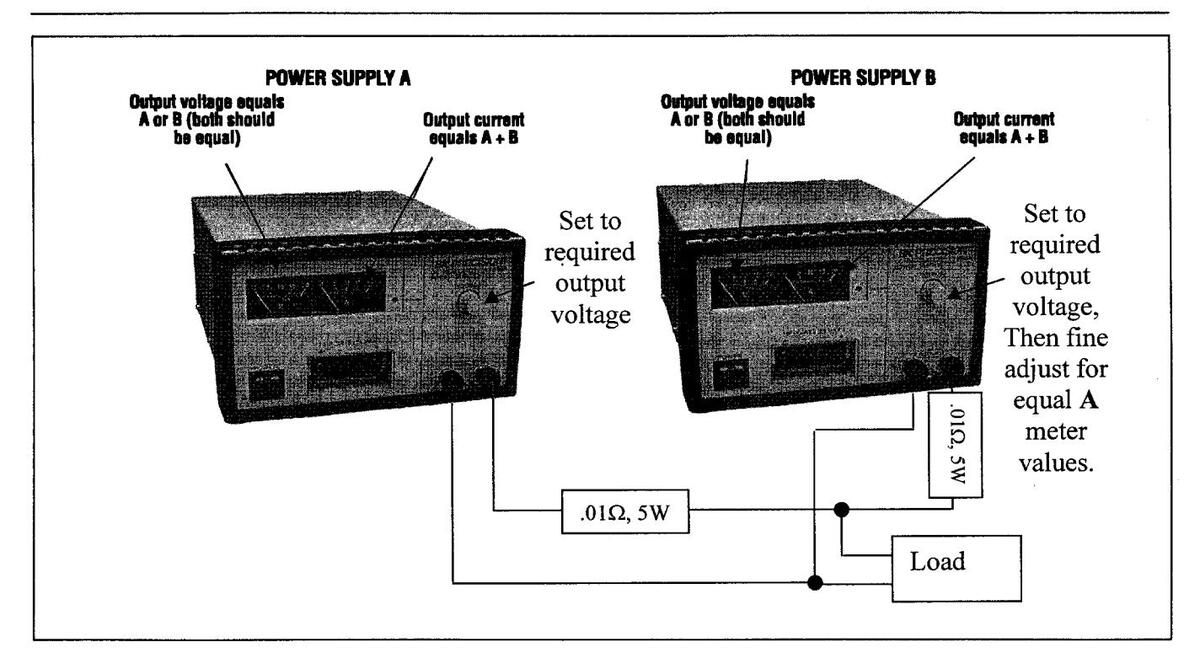INSTRUCTION MANUAL

MODEL 1688A

3 to 14 VOLT DC POWER SUPPLY

TEST INSTRUMENT SAFETY
WARNING
Normal use of test equipment exposes you to a certain amount of danger from electrical shock because testing must sometimes be performed where exposed high voltage is present. An electrical shock causing 10 milliamps of current to pass through the heart will stop most human heartbeats. Voltage as low as 35 volts dc or ac rms should be considered dangerous and hazardous since it can produce a lethal current under certain conditions. Higher voltages are even more dangerous. Your normal work habits should include all accepted practices to prevent contact with exposed high voltage, and to steer current away from your heart in case of accidental contact with a high voltage. Observe the following safety precautions:
-
1. There is little danger of electrical shock from the dc output of this power supply. However, there are several other possible test conditions using this power supply that can create a high voltage shock hazard:
- a. If the equipment under test is the "hot chassis" type, a serious shock hazard exists unless the equipment is unplugged (just turning off the equipment does not remove the hazard), or an isolation transformer is used.
- b. If the equipment under test is "powered up" (and that equipment uses high voltage in any of its circuits), the power supply outputs may be floated to the potential at the point of connection. Remember that high voltage may appear at unexpected points in defective equipment. Do not float the power supply output to more than 100 volts peak with respect to chassis or earth ground.
- c. If the equipment under test is "off" (and that equipment uses high voltage in any of its circuits under normal operation), discharge high-voltage capacitors before making connections or tests. Some circuits retain high voltage long after the equipment is turned off.
- 2. Use only a polarized 3-wire ac outlet. This assures that the power suppply chassis, case, and ground terminal are connected to a good earth ground and reduces danger from electrical shock.
- 3. Don't expose high voltage needlessly. Remove housings and covers only when necessary. Turn off equipment while making test connections in high-voltage circuits. Discharge high-voltage capacitors after removing power.
(continued on inside back cover)
TABLE OF CONTENTS
page
| TEST INSTRUMENT SAFETY | • | • | • | • | • | in | si | de | f | ro | nt | t c | :0\ | er | ||||
|---|---|---|---|---|---|---|---|---|---|---|---|---|---|---|---|---|---|---|
| INTRODUCTION | • | · | • | · | • | • | • | • | 1 | |||||||||
| SPECIFICATIONS | • | · | • | ٠ | • | • | • | · | · | 2 | ||||||||
| CONTROLS AND INDICATORS | • | · | · | 3 | ||||||||||||||
| OPERATING INSTRUCTIONS | • | 5 | ||||||||||||||||
| Safety Precautions | • | 5 | ||||||||||||||||
| Equipment Protection Precautions | - | 5 | ||||||||||||||||
| Power Supply Hook-up and Operation | 5 | |||||||||||||||||
| Considerations | 6 | |||||||||||||||||
| Current Limiting | 7 | |||||||||||||||||
| Connecting Two Supplies in Series . | 7 | |||||||||||||||||
| Connecting Two Supplies in Parallel | 7 |
| MAINTENANCE | 10 | ||||||||||
| Fuse Replacement | 10 | ||||||||||
| Line Voltage Conversion | 10 | ||||||||||
| Adjustments | 10 | ||||||||||
| Case Disassembly | 10 | ||||||||||
| Voltage and V Meter Adjustments | 11 | ||||||||||
| Current and A Meter Adjustments | 11 | ||||||||||
| Instrument Repair Service | - | • | • | • | • | • | • | 12 | |||
| WARRANTY SERVICE INSTRUCTIONS . | · | • | • | 13 | |||||||
| LIMITED ONE-YEAR WARRANTY | · | 15 | |||||||||
page
INTRODUCTION
The B+K Precision Model 1688 is a high quality 3 to 14 Volt DC Power Supply primarily designed for bench powering of automotive and marine electronic equipment. The Model 1688 has a maximum output current proportional to the voltage setting, the maximum current of 20 amps available from 13.8 to 14 volts and is reduced to 4.5 amps at 3 volts. Two panel mounted meters continuously monitor the output voltage and current.
The 20-amp output of the Model 1688 power supply allows bench powering of most any car radio, sound system (including most "highpower" car stereo receiver/amplifiers), tape systems, PA systems, and low-to-medium power 2-way radios, such as CB transceivers, VHF/UHF commercial equipment, marine, car telephone, and 2-meter transceivers.
The power supply utilizes thermostatically controlled fan cooling for improved heat dissipation and reliability while keeping bulk and weight to a minimum.
Thermostatically controlled automatic shut-down provides unparalleled reliability at very high temperatures or fan failure.
Foldback current limiting protects the power supply from accidental short circuits and overload conditions. The output is isolated from chassis and earth ground, permitting full flexibility of connections. When desired, the positive (+) or negative (-) polarity outputs may be strapped to ground, allowing use with negative-ground and positive-ground automotive equipment.
Advanced design, quality, and sturdy construction of the Model 1688 assures continued reliability. To gain the most effective use of this instrument, we recommend that you study the entire manual before operating the power supply.
SPECIFICATIONS
| OUTPUT | VOLTAGE |
|---|
3 to 14 VDC, ADJUSTABLE
OUTPUT CURRENT
| PROPORTIONAL | TO OUTPUT | VOLTAGE; |
|---|
| 3V | 4.5 |
|---|---|
| 5V | 7.5 |
| 9V | 13.0 |
| 12V | 17.0 |
| 13.8V | 20.0 |
| 14V | 20.0 |
LOAD REGULATION
| (0 to Rated Current) < | 0.84 |
|---|
LINE REGULATION
| (108-132 VAC) ≤ 0 | .8% |
RIPPLE & NOISE
PROTECTION
Current Limiting (Foldback), Reverse Polarity, Overvoltage, Short Circuit, Thermal.
METERING
Voltmeter
| Range | Accuracy |
|---|---|
| 0 to 20V | ± 7% F.S. |
Ammeter
| Range | Accuracy |
|---|---|
| 0 to 30A | ±7% F.S. |
POWER REQUIREMENTS
115/230 VAC ±10%, 50/60Hz.
POWER CONSUMPTION
580 W
TEMPERATURE RANGE & HUMIDITY
Operation
0° to +40°C ≤ 85% R.H.
Storage
-15° to +70°C ≤ 75% R.H.
DIMENSIONS (HxWxD)
4.9×8.5×11.5"(124×216×292MM)
WEIGHT
19.8 lb. (9 kg)
ACCESSORIES SUPPLIED
Instruction Manual Spare Fuse
CONTROLS AND INDICATORS
- 1. POWER Switch. Turns power supply on and off. Power on indicated by pilot lamp above switch.
- 2. Power ON light. Lights when power is turned on.
- 3. OVERLOAD Indicator. Lights when overload condition exists.
- 4. VOLTAGE Control. Adjusts output voltage. Read value on V Meter.
- 5. A Meter. Indicates output current on 0 to 30 amp. scale.
- 6. V Meter. Indicates output voltage on 0 to 20 volt scale.
- 7. OUTPUT "+" Terminal (Red). Positive polarity output terminal.
- 8. OUTPUT "-" Terminal (Black). Negative polarity output terminal.
- 9. TIE POINTS (2A MAX). Red terminals are +, Black terminals are -. Load must not exceed 2 amperes.
- 10. Line Cord.
- 11. Fuse.
- 12. Fan.
CONTROLS AND INDICATORS

Figure 1. Front Panel Controls and Indicators, Model 1688.
Figure 2. Rear Panel
OPERATING INSTRUCTIONS
SAFETY PRECAUTIONS

The following precautions must be observed to help prevent electric shock.
- 1. Use only a polarized 3-wire ac outlet. This assures that the power supply chassis and case are connected to a good earth ground and reduces danger from electrical shock.
- 2. There is little danger of electric shock from the power supply output, which produces a maximum of 14.0 volts dc. However, there may be great danger of electrical shock if the power supply output is connected to an external high voltage. Some equipment being powered may contain high voltage and present a shock hazard. Observe caution. If the power supply output is floated (referenced to a voltage rather than earth ground) turn off the power supply and the equipment under test when making connections. Never float the power supply to a potential greater than 100 volts peak with respect to earth ground.
- 3. Observe all TEST INSTRUMENT SAFETY precautions listed in the front of this manual.
EQUIPMENT PROTECTION PRECAUTIONS
CAUTION
The following precautions will help avoid damage to the power supply.
- 1. Avoid using the power supply in ambient temperatures above +40° C (104° F). Always allow sufficient air space around the fan opening at the rear of the power supply and the top and side vent openings for effective air flow to prevent internal heat build-up. Typically, a two inch space at the sides, as well as a six inch space at the top and rear of the power supply is adequate. DO NOT block the fan opening at the rear of the power supply or the vent on top of the power supply. DO NOT place objects on top of the power supply.
- 2. Although the power supply is protected against overload and short circuits, avoiding these conditions in regular use results in maximum stability and reliability.
- 3. Make certain that hook-up is as intended before turning power supply on. Incorrect polarity may damage the equipment being powered.
POWER SUPPLY HOOK-UP and OPERATION
1. Turn off the power supply and equipment being powered.
NOTE
Use solid copper hook-up wire with a minimum diameter of 12 AWG. Using smaller wire may result in overheating of the hook-up leads, and increases the source resistance "seen" by the load, thereby derating the maximum current and regulation capabilities of the power supply. Tighten connections snugly to assure low resistance.
- 2. Connect the red (+) OUTPUT terminal of the power supply to the positive polarity input of the equipment being powered.
- 3. Connect the black (-) OUTPUT terminal of the power supply to the negative polarity input of the equipment being powered.
- 4. Set the VOLTAGE control to its minimum (counter clockwise) position.
- 5. Turn on the power supply.
- 6. Turn on the equipment being powered.
- 7. Adjust the VOLTAGE control to the desired voltage as read on the V meter.
CONSIDERATIONS
- 1. Although vehicular electrical systems are typically referred to as "12 volt systems", the actual nominal operating voltage of such systems is approximately 13.8 volts. Therefore, for purposes of normal operation, adjust the power supply for 13.8 volts.
- 2. Maximum current is dependent upon output voltage as shown in Fig. 3.
- 3. The clip type TIE POINT terminals can be used to attach equipment requiring a maximum of 2 amps. Be sure to observe polarity when connecting equipment.
4. If more precision voltage readings are desired, connect a high-accuracy multimeter, such as the 0.5% B+K Precision Model 388A Digital Multimeter or equivalent across a pair of (+) and (-) TIE POINT terminals.

Figure 3. Typical Output Voltage and Output Current Characteristics
CURRENT LIMITING
Overload (Foldback) current limiting gives protection against excessive overload and short circuit output. When an overload (foldback) condition exists, the unit drops out of voltage regulation and the OVERLOAD indicator will be illuminated. The foldback characteristic shown in the graph in Fig. 3 takes effect before the primary fuse blows, dropping the output voltage and current in proportion to the degree of overload. If the output is short-circuited (maximum overload condition), the output current drops below its rating at 3V. Monitoring the output voltage and current will detect any such overload conditions.
CONNECTING TWO SUPPLIES IN SERIES (Refer to Fig. 4)
The outputs of two supplies may be connected in series to provide a variable 6-to-28 volts output. The maximum output current will remain at 20 amps. See Fig. 4 for the connection scheme.
The voltage is controlled by both VOLTAGE controls and is equal to the sum of the two V meter readings. Adjust voltage so that each power supply provides about half the total voltage.
CONNECTING TWO SUPPLIES IN PARALLEL (Refer to Fig. 5)
The outputs of two Model 1688 power supplies may be connected in parallel to double the current capacity to 40 amperes. The output voltage remains at 3-to-14 volts output. See Fig. 5 for the connection scheme.
The voltage level of both VOLTAGE controls should be set simultaneously to the same value. Fine adjust the VOLTAGE controls for equal readings on the A meters. This will allow each power supply to provide one-half of the total current. Current will be equal to the sum of both A meters. Current limiting resistors of approximately 0.01Ω, 5W will allow the VOLTAGE control settings to be more precise and less touchy.

Figure 4. Connecting Two Power Supplies in Series for a 6-to-28 Volt Output.
OPERATING INSTRUCTIONS

Figure 5. Connecting Two Power Supplies in Parallel for 3-to-14 Volt Output at Double Amperage.
MAINTENANCE

The following instructions are for use by qualified personnel only. To avoid electrical shock, do not perform any servicing other than contained in the operating instructions unless you are qualified to do so.
FUSE REPLACEMENT
If the fuse blows, the power on LED indicator will not light and the power supply will not operate. The fuse should not normally open unless a problem has developed in the unit. Try to determine and correct the cause of the blown fuse, then replace only with a fuse of the correct rating. The fuse is located on the rear panel (see Fig. 2).
| LINE | VOLTAGE | 115V | 230V |
|---|---|---|---|
| FUSE | VALUE | 5A | 2.5A |
LINE VOLTAGE CONVERSION
The primary winding of the power transformer is tapped to permit operation from 115 or 230 VAC, 50/60 Hz line voltage. Conversion from one line voltage to another is done by simply changing the position of the LINE VOLTAGE SELECT switch located on the bottom of the chassis. To convert to a different line voltage, perform the following procedure:
1. Make sure the power cord is unplugged.
- 2. Turn the unit over (bottom up) and reset the LINE VOLTAGE SELECT switch for the desired line voltage, 115V or 230V.
- 3. A change in line voltage will also require a corresponding change of fuse value. Install the correct fuse value as listed in the FUSE REPLACE-MENT section.
ADJUSTMENTS
This unit was accurately adjusted at the factory before shipment. Readjustment is recommended only if repairs have been made in a circuit affecting adjustment accuracy, or if you have a reason to believe the unit is out of adjustment. However, adjustments should be attempted only if a 3-1/2 digit multimeter with an accuracy of ±0.5% dcV or better ( B+K Precision Model 388A or equivalent) and a 0 to 1 ohm, 500 Watt adjustable resistive load is available.
If readjustment is required, use the following procedure. Locations of the electrical adjustments are shown in Fig. 6.
CASE DISASSEMBLY
- 1. Turn the unit over, bottom up, and remove the three screws that hold the front bezel to the chassis.
- 2. Remove the ten screws that hold the case top to the the chassis and front bezel.

Figure 6. Location of Calibration Adjustments, Rear View.
3. Pull the front bezel away from the chassis to access the calibration adjustments.
VOLTAGE AND V METER ADJUSTMENTS
- 1. Connect the multimeter (set to 20 DCV Range) to measure the dc voltage across the power supply (+) and (-) OUTPUT terminals.
- 2. Turn on the power supply, and set the front panel VOLTAGE control maximum (fully clockwise).
- 3. Adjust Trimmer VR3 for a reading of 14.50 ± 0.10 volts on the multimeter.
- 4. Set the power supply front panel VOLTAGE control for a reading of 14.00 ± 0.10 volts on the multimeter.
- 5. Adjust Trimmer VR4 so that the meter pointer on the V meter lines up with the 14 volt mark.
- 6. Turn off unit power to proceed to the current adjustments.
CURRENT and A METER ADJUSTMENTS
- 1. Connect the 0 to 1 ohm resistive load in series with the multimeter (set to 20 DCA Range) to measure the dc output current across the power supply (+) and (-) OUTPUT terminals.
- 2. Turn on the power supply and adjust the resistive load for a reading of 20.0 ± 0.1 amps on the multimeter.
- 3. Adjust Trimmer VR5 so that the meter pointer on the A meter lines up with the 20 amp mark.
MAINTENANCE
- 4. Remove the multimeter in series with the load, and reconnect it in parallel with the load to measure voltage (set to 20 DCV Range).
- 5. Adjustable Trimmer VR2 fully counter clockwise, looking at the front of the unit.
- 6. Re-sdjust the power supply front panel VOLTAGE control for a reading of 14.0 ±0.5 volts on the multimeter if necessary.
- 7. Adjust the resistive load for a reading of 25 amps on the unit's A meter scale.
- 8. Adjustable Trimmer VR2 clockwise unit the output voltage read on the multimeter drops by 0.05 to 0.20 V.
INSTRUMENT REPAIR SERVICE
Because of the specialized skills and test equipment required for instrument repair and calibration, many customers prefer to rely upon B+K Precision for this service. We maintain a network of B+K Precision authorized service agencies for this purpose. To use this service, even if the instrument is no longer under warranty, follow the instructions given in the WARRANTY SERVICE INSTRUCTIONS section of this manual. There is a nominal charge for instruments out of warranty.
WARRANTY SERVICE INSTRUCTIONS (For U.S.A. and its Overseas Territories)
- 1. Refer to the MAINTENANCE section of your B+K Precision instruction manual for adjustments that may be applicable.
- 2. If the above-mentioned does not correct the problem you are experiencing with your unit, pack it securely (preferably in the original carton or double-packed).
- 3. Enclose a letter describing the problem and include your name and address.
- 4. Enclose proof of purchase date; that is, a dated copy of the sales receipt.
- 5. Deliver to, or ship PREPAID (UPS preferred in U.S.A.) to the nearest B+K Precision authorized service agency (see list enclosed with unit).
If your list of authorized B+K Precision service agencies has been misplaced, contact your distributor for the name of your nearest service agency, or write to:
B&K Precision Corporation 22820 Savi Ranch Parkway Yorba Linda, California 92887 www.bkprecision.com (800) 462-9832
Also use this information for techical and replacement parts inquires
Limited One-Year Warranty
B&K Precision Corp. warrants to the original purchaser that its product and the component parts thereof, will be free from defects in workmanship and materials for a period of one year from the data of purchase.
B&K Precision Corp. will, without charge, repair or replace, at its' option, defective product or component parts. Returned product must be accompanied by proof of the purchase date in the form a sales receipt.
To obtain warranty coverage in the U.S.A., this product must be registered by completing and mailing the enclosed warranty card to B&K Precision Corp., 22820 Savi Ranch Pkwy, Yorba Linda, CA 92887 within fifteen (15) days from proof of purchase.
Exclusions: This warranty does not apply in the event of misuse or abuse of the product or as a result of unauthorized alternations or repairs. It is void if the serial number is alternated, defaced or removed.
B&K Precision Corp. shall not be liable for any consequential damages, including without limitation damages resulting from loss of use. Some states do not allow limitation of incidental or consequential damages, so the above limitation or exclusion may not apply to you.
This warranty gives you specific rights and you may have other rights, which vary from state-to-state.
Model Number: _____
Date Purchased: _____
(continued from inside front cover)
- 4. If possible, familiarize yourself with the equipment being tested and the location of its high voltage points. However, remember that high voltage may appear at unexpected points in defective equipment.
- 5. Use an insulated floor material or a large, insulated floor mat to stand on, and an insulated work surface on which to place equipment; and make certain such surfaces are not damp or wet.
- 6. When testing ac powered equipment, the ac line voltage is usually present on some power input circuits such as the on-off switch, fuses, power transformer, etc. "any time" the equipment is connected to an ac outlet, even if the equipment is turned off.
- 7. B+K Precision products are not authorized for use in any application involving direct contact between our product and the human body, or for use as a critical component in a life support device or system. Here, "direct contact" refers to any connection from or to our equipment via any cabling or switching means. A "critical component" is any component of a life support device or system whose failure to perform can be reasonably expected to cause failure of that device or system, or to affect its safety or effectiveness.
- 8. Never work alone. Someone should be nearby to render aid if necessary. Training in CPR (cardio-pulmonary resuscitation) first aid is highly recommended.


















